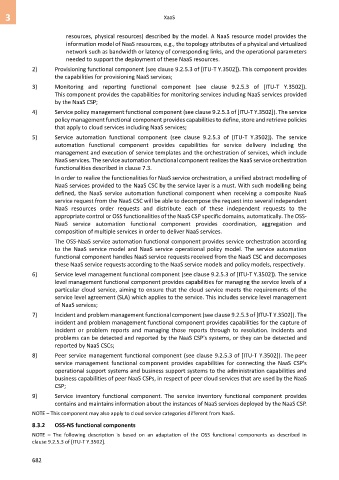Page 690 - Cloud computing: From paradigm to operation
P. 690
3 XaaS
resources, physical resources) described by the model. A NaaS resource model provides the
information model of NaaS resources, e.g., the topology attributes of a physical and virtualized
network such as bandwidth or latency of corresponding links, and the operational parameters
needed to support the deployment of these NaaS resources.
2) Provisioning functional component (see clause 9.2.5.3 of [ITU-T Y.3502]). This component provides
the capabilities for provisioning NaaS services;
3) Monitoring and reporting functional component (see clause 9.2.5.3 of [ITU-T Y.3502]).
This component provides the capabilities for monitoring services including NaaS services provided
by the NaaS CSP;
4) Service policy management functional component (see clause 9.2.5.3 of [ITU-T Y.3502]). The service
policy management functional component provides capabilities to define, store and retrieve policies
that apply to cloud services including NaaS services;
5) Service automation functional component (see clause 9.2.5.3 of [ITU-T Y.3502]). The service
automation functional component provides capabilities for service delivery including the
management and execution of service templates and the orchestration of services, which include
NaaS services. The service automation functional component realizes the NaaS service orchestration
functionalities described in clause 7.3.
In order to realize the functionalities for NaaS service orchestration, a unified abstract modelling of
NaaS services provided to the NaaS CSC by the service layer is a must. With such modelling being
defined, the NaaS service automation functional component when receiving a composite NaaS
service request from the NaaS CSC will be able to decompose the request into several independent
NaaS resources order requests and distribute each of these independent requests to the
appropriate control or OSS functionalities of the NaaS CSP specific domains, automatically. The OSS-
NaaS service automation functional component provides coordination, aggregation and
composition of multiple services in order to deliver NaaS services.
The OSS-NaaS service automation functional component provides service orchestration according
to the NaaS service model and NaaS service operational policy model. The service automation
functional component handles NaaS service requests received from the NaaS CSC and decomposes
these NaaS service requests according to the NaaS service models and policy models, respectively.
6) Service level management functional component (see clause 9.2.5.3 of [ITU-T Y.3502]). The service
level management functional component provides capabilities for managing the service levels of a
particular cloud service, aiming to ensure that the cloud service meets the requirements of the
service level agreement (SLA) which applies to the service. This includes service level management
of NaaS services;
7) Incident and problem management functional component (see clause 9.2.5.3 of [ITU-T Y.3502]). The
incident and problem management functional component provides capabilities for the capture of
incident or problem reports and managing those reports through to resolution. Incidents and
problems can be detected and reported by the NaaS CSP's systems, or they can be detected and
reported by NaaS CSCs;
8) Peer service management functional component (see clause 9.2.5.3 of [ITU-T Y.3502]). The peer
service management functional component provides capabilities for connecting the NaaS CSP's
operational support systems and business support systems to the administration capabilities and
business capabilities of peer NaaS CSPs, in respect of peer cloud services that are used by the NaaS
CSP;
9) Service inventory functional component. The service inventory functional component provides
contains and maintains information about the instances of NaaS services deployed by the NaaS CSP.
NOTE – This component may also apply to cloud service categories different from NaaS.
8.3.2 OSS-NS functional components
NOTE – The following description is based on an adaptation of the OSS functional components as described in
clause 9.2.5.3 of [ITU-T Y.3502].
682

